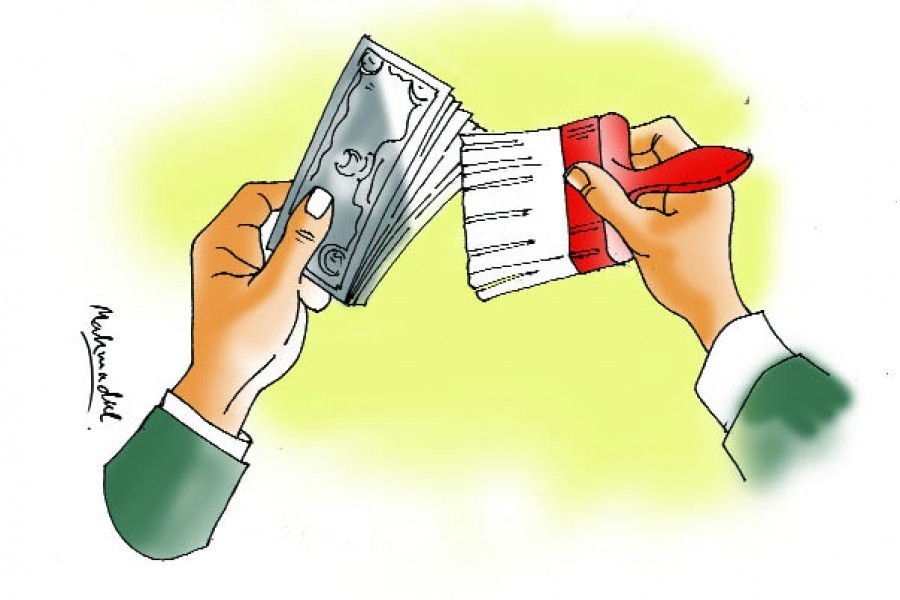
Published :
Updated :

The presence of a sizeable volume of black money is a harsh reality in Bangladesh like many other developing countries. That is why the debate on the issue of whitening black money has been rather frequent here. The debate usually intensifies a few weeks before the announcement of the annual budget and it continues until the budget is passed. This year is also no exception. An FE report suggested that at least Tk 142 billion was whitened in the first nine months of the current fiscal year amidst the pandemic.
Opponents and critics of the money whitening scheme always termed the scope given to whiten the black money unethical and discriminatory. They argued that by providing such scope, the authorities ultimately encourage corruption and rent-seeking. Moreover, such a legal option discriminates against the honest taxpayers who pay their income taxes at a higher rate than those who disclosed their undeclared or hidden income by paying only 10 per cent tax.
In official term, there is no scheme to legalise the black money except for disclosing the undeclared income. Individual taxpayers are now allowed to reveal any undisclosed house property, including land, building, flat, and apartment, by paying tax at a particular rate per square meter of the said asset. Individual taxpayers can also disclose the undeclared cash, bank deposits, savings certificates, shares, bonds or any other securities by paying tax at a rate of 10 per cent on the value of the said declaration. Finally, individual taxpayers are eligible to invest money in the capital market showing it in their tax returns by paying 10 per cent tax on the value of the investment on the condition that there will be a lock-in period of three years. The three provisions offered to whiten black money will be effective until June 30 this year.
According to a media report, during the first nine months of the current fiscal year (FY21), some 10,034 people legalised cash and assets worth Tk 142.95 billion under the provisions. Of them, a total of 9,693 people declared Tk 138.60 billion mainly in cash, fixed deposit receipts, saving certificates and assets. The rest amounting to Tk 4.35 billion was whitened through investment in the capital market. The National Board of Revenue (NBR) received Tk 14.39 billion in taxes against the legalisation of the undisclosed fund during the period under review.
The core legal coverage of the one-year schemes is that 'no authority including the income tax authority can raise any question on such declarations.' The logic behind these schemes or any other such provision is to bring the so-called hidden income into the mainstream economy. The reason is, however, flawed. The secret or undeclared income is already invested in the financial or tangible assets except the amount illegally transferred abroad. Only a tiny portion of black money is held in cash. The declared amount of black money worth Tk 138.60 billion had already been deposited in banks and invested in government bonds, the savings certificates to be precise, and real estates. Thus, the money was not hidden in the real sense. The depositors and investors are also paying due taxes at sources on the interests and profits generated from the deposits. What happened is that the owners declared it to the tax authorities by paying 10 per cent tax. They took advantage of the tax amnesty as none would ask any question about the sources of the said income. The NBR also earned a tiny amount of taxes in this process.
One thing is clear. The sources of undeclared funds are dubious, so the deposit holders tried to conceal it from the tax authorities. If the income is legal, there is little reason to keep it hidden.
It is a tricky step, no doubt. The government has, possibly, assumed that the black money whitening facility will contain the capital flight. Some economists also tend to believe that the recent rise in money whitening is mainly due to the difficulty being faced to transfer money abroad illegally. They, however, attributed it to the pandemic, which squeezed the scope of the illegal transfer of money for the time being.
Then again, the increase in money laundering at home highlights the existence of deep-rooted corruption in the country. Inflated costs of some development projects over the years reflect the extent of corruption and bribe-taking. Though the government is not very comfortable with this phenomenon, it is also not able to avoid the reality. That's why it has provided some legal opportunities to whiten the black money and indirectly admitted the extent of corruption. It is an important job for the government to rein in large-scale corruption by establishing good governance. However, without appropriate administrative and fiscal measures in place, such an objective will remain as elusive as ever.
Allowing black money to be invested in health and education sectors could be an option in this connection. In fact, in a citizen dialogue a few weeks ago, some business leaders and civil society members argued that there might be some provisions to allow investment of undeclared income in education, health and manufacturing sectors. They, however, opined that such an option should be for the time being and not for an unlimited period.
In the last year's budget speech, the finance minister maintained that the opportunity offered to legalise undeclared funds would 'increase the flow of money into the mainstream economy, generate employment, and enhance tax revenue collection.' It is thus would be a rational expectation that he will provide an estimate of the actual outcome of the money whitening facility in the upcoming budget speech, which he is expected to deliver on June 3 next.


 For all latest news, follow The Financial Express Google News channel.
For all latest news, follow The Financial Express Google News channel.